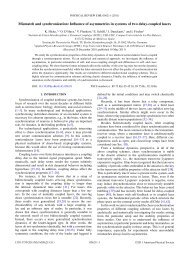DBI Analysis of Open String Bound States on Non-compact D-branes
DBI Analysis of Open String Bound States on Non-compact D-branes
DBI Analysis of Open String Bound States on Non-compact D-branes
Create successful ePaper yourself
Turn your PDF publications into a flip-book with our unique Google optimized e-Paper software.
CHAPTER 6. SETTING 78If we imagine a D1-brane stretching out in x 6 approaching and ultimately hitting anNS5-brane, it will be cut into two pieces, namely two semi-<strong>compact</strong> D1-<strong>branes</strong>. Theyare semi-<strong>compact</strong>, because <strong>on</strong> <strong>on</strong>e side they stretch out to infinity, while <strong>on</strong> the otherthey end <strong>on</strong> the NS5-brane.If we imagine a D1-brane stretching out in x 6 hitting two NS5-<strong>branes</strong>, it will be cutinto three pieces, namely two semi-<strong>compact</strong> D1-<strong>branes</strong> and <strong>on</strong>e <strong>compact</strong> D1-brane, i.e.a D-brane that ends <strong>on</strong> both sides <strong>on</strong> an NS5-brane.Both these possibilities are illustrated in Fig. 6.2. A n<strong>on</strong>-<strong>compact</strong> D-brane is thussimply a brane that extends to infinity <strong>on</strong> both sides.D1-braneD1-braneCompactD1NS5-ringSemi-CompactD1Semi-<strong>compact</strong>D1NS5-ringSemi-<strong>compact</strong>D1Figure 6.2: Graphical illustrati<strong>on</strong> <str<strong>on</strong>g>of</str<strong>on</strong>g> (semi)-<strong>compact</strong> D1-<strong>branes</strong> in the presence <str<strong>on</strong>g>of</str<strong>on</strong>g> anNS5-ring.6.2.2 <str<strong>on</strong>g>Bound</str<strong>on</strong>g> statesIt has been menti<strong>on</strong>ed before that open strings can be regarded as excitati<strong>on</strong>s <str<strong>on</strong>g>of</str<strong>on</strong>g> D-<strong>branes</strong>. Such an open string satisfies Dirichlet boundary c<strong>on</strong>diti<strong>on</strong>s in the directi<strong>on</strong>snormal to the brane, meaning in c<strong>on</strong>creto that the endpoints <str<strong>on</strong>g>of</str<strong>on</strong>g> such a string are attachedto the world volume <str<strong>on</strong>g>of</str<strong>on</strong>g> the D-brane. But as l<strong>on</strong>g as they remain attached, they are freeto move <strong>on</strong> it as they please.In the presence <str<strong>on</strong>g>of</str<strong>on</strong>g> an NS5-ring, things change. Focusing again <strong>on</strong> a D1-<strong>branes</strong>tretched in the x 6 directi<strong>on</strong>, an open string attached to the brane can in principlemove freely al<strong>on</strong>g the brane. When the D1-brane is located close enough to the NS5-ring however, something radical happens: some excitati<strong>on</strong>s close to the NS5-ring remainbound, i.e. they cannot move anymore! Such a state is exactly what is called a boundstate. This is illustrated in Fig. 6.3.6.2.3 <str<strong>on</strong>g>DBI</str<strong>on</strong>g> approachThe Dirac-Born-Infeld acti<strong>on</strong> is said to be a low-energy acti<strong>on</strong>. What does this entail?For <strong>on</strong>e, the <str<strong>on</strong>g>DBI</str<strong>on</strong>g> acti<strong>on</strong> is c<strong>on</strong>structed entirely out <str<strong>on</strong>g>of</str<strong>on</strong>g> the massless fields present in the((NS,NS)-sector <str<strong>on</strong>g>of</str<strong>on</strong>g> the open) string spectrum. In other words, the <str<strong>on</strong>g>DBI</str<strong>on</strong>g> acti<strong>on</strong> <strong>on</strong>lyc<strong>on</strong>siders the lowest energy excitati<strong>on</strong>s <str<strong>on</strong>g>of</str<strong>on</strong>g> the open string. As such, when we vary the<str<strong>on</strong>g>DBI</str<strong>on</strong>g> acti<strong>on</strong> to obtain the excitati<strong>on</strong>s <str<strong>on</strong>g>of</str<strong>on</strong>g> the D-brane it describes, and hence the spectrum
















